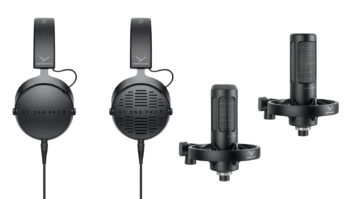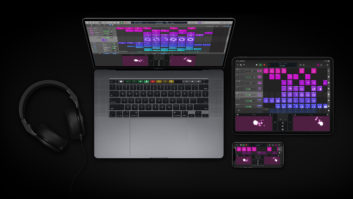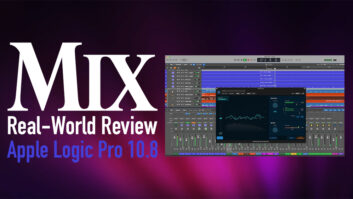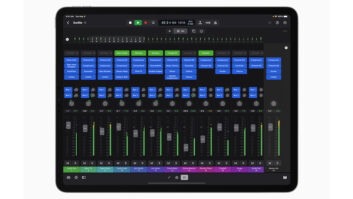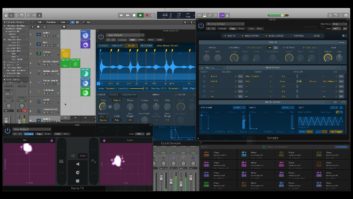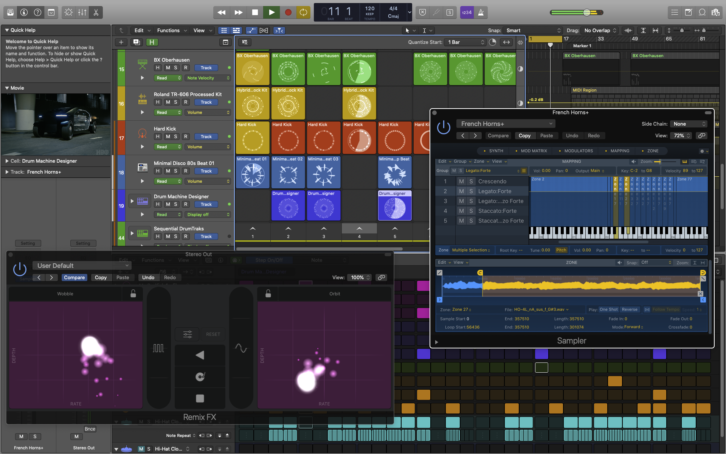
After well over two years since the 10.4 update, stalwart Logic enthusiasts found themselves less enthused over Apple’s neglect of its professional DAW while the company instead tried to sell suckers a new watch every nine months. When the dam finally broke, thirsty Logic pros met a deluge of new tools and capabilities, mostly aimed at dancefloor-oriented music production. The updates almost feel like a second program added on top of Logic Pro, except that they’re integrated with the smooth panache one has come to expect from the engineers of the trillion-dollar orchard.
As a long-time Ableton Live and Bitwig Studio user who recently turned to Apple Logic Pro X to delve into scoring to picture, I saw the hefty Logic Pro X 10.5 makeover as the perfect update at the perfect time.
There’s no mistaking Ableton Live’s influence upon Logic Pro X 10.5’s additions. Its new Live Loops Grid incorporates nonlinear, loop-based composition, arrangement and performance that Live first brought to DAW software. Its new Drum Synths and Step Sequencer fill in feature gaps that Live and other software like Native Instruments Maschine have emphasized with their companion sequencing hardware. Even Logic’s streamlined and enhanced new Sampler and Quick Sampler, which every Logic Pro X user can benefit from regardless of whether they work in electronic beat genres, mimic Ableton’s Sampler/Simpler dynamic.
While this remixy bag of tricks may not be exactly what all Logic Pro users wanted, it is exactly what some of them did. Although Ableton Live has taken the spot of most popular DAW, many young electronic music producers have flocked toward Logic Pro, even before this update. Logic Pro X 10.5’s new tools make capturing ideas even faster, more fun and creatively expansive. Let’s see how the new components work and how well they oil up the entire machine.
Live Loops & Remix FX
Logic Pro 10.5’s new Live Loops Grid brings a whole new workspace to the DAW for creating nonlinear, loop-based performances. While reminiscent of the clip-launching views in Ableton Live and Bitwig Studio, the Live Loops Grid and its loop “cells” recall what Apple’s Garageband for iOS actually incorporated several years ago, but with greater editing and recording possibilities.
You can populate each cell by dragging and dropping MIDI or audio loops, regions, or one-shots from the Browser or Tracks views, as well as by real-time recording or step recording from the Step Sequencer. From either the Cell Inspector or contextual menus, you can edit the cells’ playback modes and start/stop positions, quantization, velocity, transposition, and other traits, as well as bounce cells to audio or save them to your Loop Library.
Double-clicking a cell opens the audio editor, MIDI editor or step sequencer, depending on the cell type, so you have a high level of control over the music you’re creating within the Live Loops Grid. Genre-based starter grids can get you up and running quickly.
To play back—or perform with—the cells, you can launch them with the mouse either individually or by vertical “scenes,” which play cells from all the tracks available at once. This is where the Logic Remote 1.4 app for iPad or iPhone comes in really handy, because it’s been updated with a Live Loops screen that, when connected to Logic Pro over a Wi-Fi network, works with negligible latency to launch Live Loops cells, as if you had a dedicated wired MIDI controller for the job. If that’s your preference, however, Novation’s Launchpad button grid controllers integrate with the Live Loops Grid, and I successfully tested a Launchpad Pro for this purpose.
If you’re scoring to a Movie in the Tracks Area, the Movie will play while you work with the Live Loops, and you can set of a loop region to repeat the video while you’re working in the loops grid if you like.
The Performance Recording button at the top of the Live Loops Grid starts recording the Live Loops Grid’s tracks to the corresponding numbered tracks in the linear Tracks Area, where you can then incorporate them into your larger project. As a unique feature that you won’t find in Ableton Live or Bitwig Studio, you can keep certain tracks active in the Tracks Area while working on the performance of other active tracks in the Live Loops Grid, so you don’t have to stress about getting a perfect take of a recorded loops performance.
Intended to enhance the Live Loops but available to all tracks, the new Remix FX plug-in presents a collection of beat-synced rhythmic effects along with two x/y pads and two slider strips for applying a variety of stutter effects, filtering, bitcrushing, and other dance music–oriented effects. Again, using the iOS Logic Remote makes operating Remix FX more effective with its multi-touch capability. A couple of the one-touch DJ vinyl effects sound a bit dated and/or cheesy, but the plug-in has mostly creatively useful effects for adding spontaneity and vitality to tracks or a full mix.
Step Sequencer
Probably my favorite addition to Logic Pro X 10.5, the new Step Sequencer is also the best stock DAW step sequencer I’ve seen for its combination of user-friendliness and enormous editing power. A MIDI editor you can use in both the Tracks View and Live Loops Grid, it not only sequences beats but can also create melodic sequences and plug-in parameter automation.
It’s easy to change step values from 12-64 steps, and the sequencer then intelligently adapts the existing pattern to the new length. Each sequencer row (track) can have its own length, time signature and playback mode (reverse, forward/backward, etc.), making endlessly varied patterns possible. About a dozen Edit modes for each step include velocity, gate, transpose, offset and, best of all, note repeat, which applies 2-16 note repetitions per step, so you can easily make trap-style hi-hat patterns and other rhythmic variations within the confines of an otherwise 4/4 pattern. There’s also randomization for every edit mode.
A bevy of preset patterns give you starting points for beats, basslines and melodies, and you can save your own creations to the Pattern Browser. Dozens of scale templates set you up for melodic sequences, or it can snap your melodies to the project master key.
Overall, the Step Sequencer is a fun track machine for cranking up your productivity. It seems odd that the Logic Remote app does not yet operate the Step Sequencer; adding that would amplify the workflow even more.
Drum Synth & Drum Machine Designer
The new Drum Synth doesn’t break any ground, but it fills a hole in the tradition of similar instruments in Ableton Live and NI Maschine for a quick and simple way to dial in synthesized drum sounds to your taste. It contains a handful of essential presets for kicks, snares, cymbals, hats, claps, and other percussion, with timbre-shaping necessities like pitch, tone, decay, and others.
Drum Synth ties into the newly enhanced Drum Machine Designer (DMD), whose 64 drum pads usually host either a Drum Synth or a Quick Sampler instrument—with editing controls embedded—but can also host third-party plug-ins. A DMD track header or Mixer track can unfold to reveal individual tracks for all the embedded sounds. The DMDs also work naturally well with the Step Sequencer.
A large new batch of content that comes with Logic Pro X 10.5 includes 70 mostly excellent DMD kits that range from necessary vintage drum machines by Roland, Linn and Simmons to modern rap and electronic dance styles. The other new content includes more than 2,500 diverse-genre loops and 1,500 instrument patches, all of which only go to increase Logic Pro’s already incredible value.
Sampling With Sampler
Apple took all the creative juices it saved when naming the new Sampler instrument and applied it to redesigning this sleeker replacement to the EXS24 sampler with a more streamlined and automated workflow, as well as upgraded synthesis capabilities. However, Sampler still saves to .exs files and is backward-compatible with all EXS24 instruments.
Creating multisample instruments is a fairly painless process. You drag a group of samples into the Mapping area, and Sampler dynamically changes the number and size of keyboard zones as you mouse over the area. This is very smart and can save a lot of time. It’s a fairly intuitive, visual process to set up the keyboard mapping, including adding multiple samples per key with velocity ranges for triggering samples and to create multiple Groups per Sampler instrument and multiple Zones per Group. And you have meticulous control over each note’s sample start/end points, loop ranges, crossfades and more in the Zone area of the one-window Sampler.
Sampler’s enhanced synthesis includes a larger selection of filter types with blending, many modeled off of classic synths and two coming from Logic Pro’s flagship Alchemy synth. The comprehensive Mod Matrix section leaves no stone unturned for creatively routing the redesigned modulators.
The Quick Sampler pares down Sampler’s synthesis, modulation and waveform editing abilities for a fast alternative to creating playable instruments from a single audio file that you can either drag in or record straight into the Quick Sampler. Imported audio is automatically set to Slice mode for drum loops, Classic mode for melodic sounds, or One Shot mode. Whichever way, Flex Time lets you edit sample length and pitch independently. You can send the resulting group of drum loop slices to a new Drum Machine Designer for a really cool way to make a new drum machine out of a single loop.
Apple also deposited the MainStage software’s Auto Sampler plug-in into Logic Pro X 10.5. An absolute gift for instrument creators, Auto Sampler automates the recording of a multisampled Sampler instrument from any MIDI external hardware or plug-in instrument. You just need to do the initial setup of how many samples to capture per note, how many semitones between samples, sustain length, velocity layers (up to 16), and so on. The auto recording saves to a .exs patch that you can open right up in Sampler as a way of archiving analog synth patches or playing complex signal chains or stacked track groups as a single instrument.
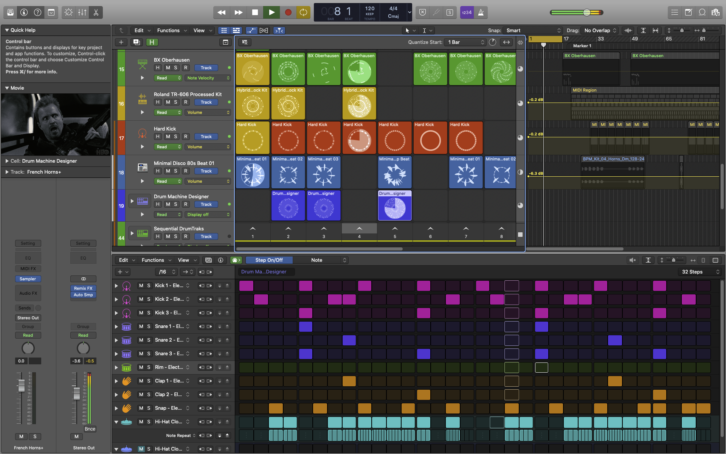
Makes All the Sense for the Dollars
While testing Logic Pro X 10.5, I worked on both scoring projects and pop-format dance tunes on a 2017 MacBook Pro with a 3.1GHz i7 processor running MacOS 10.15.6 Catalina. The update only works on Catalina, which was a sore point for me at first. I tend to suspect Apple of playing in the arena of planned obsolescence a little more than I’d like. However, it’s hard to complain when the result of a forced upgrade is virtually flawless operation. Aside from Logic Pro constantly asking me to delete AU plug-ins it doesn’t recognize every time the program boots up, there was not a hiccup to be had in my sessions with the software.
I basically admitted up front that I’m the perfect target audience for this update: an electronic dance music junkie who wants the deep, rock-solid traditional DAW package so I can explore scoring to picture. (I think that’s what all middle-aged ravers want.) Yet while Logic Pro X 10.5 does feel like a whole second workflow option was added onto it, none of the new features get in your way. They can only help.
Not only that, but the new features work beautifully together, very much as a connected system. For example, the Quick Sampler can feed into the Drum Machine Designer, which can feed into the Step Sequencer, which can feed into the Live Loops Grid, which can feed into the good ol’ trusty Tracks View. Like the closed loop of nature, there is no waste.
This would have been a major update for many DAWs. Perhaps the fact that this isn’t a Logic Pro X 11 review suggests that the floodgates are now open for good and that the river will flow unfettered into something really staggering for a v11 release. Unfortunately, it could just as likely take another two years for something all-encompasing.
Either way, I’ve been telling people for years that Logic Pro X is the best $199 a person could spend on music software, at least if they’re in the market for a DAW. This impressive update only strengthens that claim. And with the Apple Silicon chips set to make their Mac debut by the end of this year, it’s a perfect time for Apple to renew its commitment to all of its professional media-creation software while intimately leveraging the power of its own in-house processors. The logic is undeniable.
PRODUCT SUMMARY
COMPANY: Apple
PRODUCT: Logic Pro 10.5
WEBSITE: www.apple.com/logic-pro/
PRICE: $199
PROS: Enhanced Sampler with streamlined workflow. Powerful and user-friendly Step Sequencer. Live Loops Grid for a nonlinear option toward music-making. Revamped drum ecosystem including enhanced Drum Machine Designer, Drum Synths, and many new kits and sounds.
CONS: For MacOS 10.15 Catalina only. Logic Remote does not control the Step Sequencer. Upon Logic Pro’s launch, Apple constantly wants to trash AU plug-ins that it doesn’t “recognize.”
